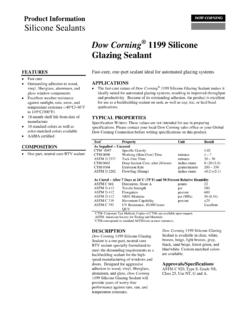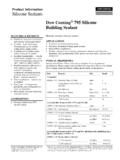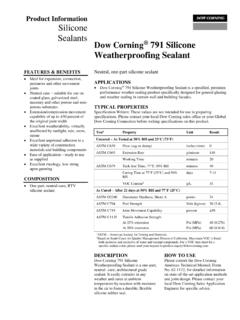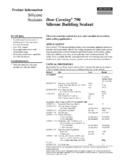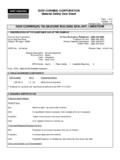Transcription of Product Information Silicone Sealants Dow …
1 Product InformationSiliconeSealantsFEATURES Easy to use All-temperature gunnability Unprimed adhesion Seals irregular surfaces High movement capability Low modulus Fully elastic Resilient Good weatherability Fast cure typically tack-freesurface in one hour or less Long-life reliabilityCOMPOSITION One-part, cold-applied Silicone thatcures to a durable, flexible, low-modulus Silicone rubber joint sealDow Corning 888 Silicone Joint SealantLow-modulus Silicone sealant for new and remedial joint sealingapplications in Portland cement concreteAPPLICATIONS Sealing transverse contraction and expansion joints, longitudinal, center lineand shoulder joints in Portland cement concrete (PCC)TYPICAL PROPERTIESS pecification Writers: Please contact your local Dow Corning Sales Application Engineer orDow Corning Customer Service before writing specifications on this SuppliedColorGrayFlow, Sag or SlumpNilExtrusion Rategrams per minute90-250 Specific Time, at 25 C (77 F)minutes10 Tack-Free Time, at 25 C (77 F)minutes60 Cure Time, at 25 C (77 F)days7-14 Full Adhesiondays14-21As Cured after 7 days at 25 C (77 F) and 50 percent RHElongation, minimumpercent1200 Modulus, at 150 percent elongation,maximumpsi (kPa)45 (310)Durometer Hardness, Shore Apoints15-25 Joint Movement Capability,+100/-50 percent, 10 cyclesNo failureAdhesion to Concrete, minimum elongationpercent+500 DESCRIPTIONDow Corning 888 Silicone JointSealant can be used as the originalsealant in new concrete constructionor as a remedial or repair sealant inold construction.
2 In new construction,it provides the extra insurance neededif all the shrink or contraction cracksdo not occur during the initial weak-ening step. Thus, two or three con-crete lengths act in unison, stressing asealant two or three times the designdimensions or of its low-modulus character-istics and good extension/compressionrecovery (+100/-50 percent of originaljoint width), Dow Corning 888 SiliconeJoint sealant gives outstandingperformance in highway, airportand bridge joints in which highmovement concrete contraction/expansion joints are generally sealedto prevent erosion of pavement sub-base and/or corrosion of metal tie barsembedded in the concrete. Such cor-rosion results from water and deicingchemicals entering the joints at thepavement of highway joints also pre-vents spalling and breakage of con-crete along the slab edge, whichoccurs when noncompressibles (dirt,stones and/or ice) are forced into orform in the use in repair or remedialapplications where other joint sealingmaterials have failed because ofexcessive movement or poor weather-ability, Dow Corning 888 SiliconeJoint sealant can be used to sealirregularly shaped and/or spalledjoints.
3 Thus, the joints do not needreforming before sealing. These jointsshould be dry and free of all oldsealing Easy to use one-component, cold-applied, ready-to-use as supplied;no mixing required; dispenseddirectly from bulk container intojoint by hand or with an air-powered pump. All-temperature gunnability consistency is relatively unchangedover normal installationtemperature range. Unprimed adhesion primer is notrequired for bonding to PCC. Foroptimum adhesion, the surfacemust be clean, dry and frost-free. Seals irregular surfaces can beused to seal joints where spallshave occurred, provided adequatecontact is made between sealantand substrate. High movement capability thesealant will perform in acontinuous joint movement of+100/-50 percent. In newconstruction, it will take the 25percent movement of each of twoor three slab lengths working inunison before all the shrink orcontraction cracks occur. Low modulus the sealantstretches 100 percent in the jointwith very little force.
4 This placesvery little strain on the bond line orjoint wall, which maximizes theprobability of a successful seal withcontinuous joint movement. Jointmovement caused by temperature,traffic and faulting requires asealant that does not strongly resiststress and/or shear. Fully elastic the sealant can bestretched to 100 percent or com-pressed to 50 percent of the jointbond width and held there. Whenreleased, it will recover 95 percentor greater of the originaldimension. The extension and/orcompression can be repeated manytimes and the sealant will resumeits original shape without splits orcracks. Thus, when properlyinstalled in a highway contractionjoint, it does not pump out of thejoint during compression. Nor doesit split, crack or lose adhesionduring extension. Resilient once cured, the sealantprevents stones and other noncom-pressibles from entering the jointby squeezing them out as soon asthe force pushing these noncompres-sibles into the sealant is removed.
5 Good weatherability its 100 per-cent Silicone rubber is virtuallyunaffected by sunlight, rain, snow,ozone or temperature extremes. Fast cure typically, the sealantwill have a tack-free surface in onehour or less. With this fast cure andrecessed joint design, the road canbe opened soon after sealing inmost applications. Long-life reliability under normalconditions, cured sealant staysrubbery from -45 to 149 C (-49 to300 F) without tearing, cracking orbecoming StandardsMeets and/or exceeds ASTM D 5893-96 Standard Specification for ColdApplied, Single Component,Chemically Curing Silicone JointSealant for Portland Cement ConcretePavements, Type NS (Non-Sag). Inaddition, the Federal AviationAdministration has published the FAA Engineering Brief 36 SiliconeJoint Sealants . This publicationapproves the use of these materials inairfield and exceeds both FederalSpecifications TT-S-001543A Class A(one-part Silicone Sealants ) and TT-S-00230C Class A (one-componentsealants) that were written forconstruction Sealants requiringextremely high movement meets Canadian Specification19GP9 Type I and approximately 41 Department of Transportation (DOT)Figure 1: Good Joint Design1.
6 Joint width wide enough to accommodate movement. (For additional Information on jointwidth, see papers by Spells and Klosowski, Silicone Sealants for Use in ConcreteConstruction, Vol. 1, No. 1, American Concrete Institute, SP-70, 1981; Cook, Construction Sealants and Adhesives, Wiley-Interscience, 1970; and Klosowski, Sealants in Construction, Marcel Dekker, 1989.)2. Joint sawed deep enough to allow backer rod/ sealant placement and space for pumpingof old sealant compounds. NOTE: This applies to standard joints only; void space beneathbacker rod in new construction is not Proper backer rod placement to prevent three-sided sealant installed to proper depth and sealant tooled 1/4 to 1/2 inch (6 to 13 mm) below pavement Depth of lowest slab determines the amount of recess required if grinding is anticipated;once grinding is complete, the sealant will have proper recess below the pavement CUT JOINT FORNEW CONSTRUCTIONDESIGN IF GRINDING ISANTICIPATEDSTANDARD JOINT specifications that require a low-modulus sealant with high TO USEP lease refer to the Pocket InstallationGuide for additional Information onapplications, preparation and installa-tion Dow Corning 888 Silicone Joint sealant easily with-stands extreme joint movement whenproperly applied.
7 The sealant willwithstand 100 percent extension and50 percent compression of the originaljoint width. However, the recom-mended joint movement design is for 25 percent (50 percent total) and notat the sealant limits. This differenceensures a successful seal when job sitejoint widths are different thandesigned widths. Therefore, the jointdesign dimensions should be less thanthe ultimate sealant thin bead of Silicone sealant willaccommodate more movement than athick bead. Dow Corning 888 SiliconeJoint sealant should be no thicker than1/2 inch (13 mm) and no thinner than1/4 inch (6 mm). Within these limits,the sealant width-to-depth ratio shouldbe 2 all cases, the sealant must berecessed below the pavement surfaceat least 3/8 inch (9 mm) with 1/2 inch(13 mm) recess being acceptable inwider joints (see Table I). Consider-ation should also be given to otherpossible road-working operations,such as diamond-grinding of thesurface. Activities of this type wouldrequire the sealant bead to be recessedeven Corning 888 Silicone JointSealant is a nonsag sealant .
8 Thisallows its use in vertical curb joints aswell as horizontal a non-leveling sealant ,Dow Corning 888 Silicone JointSealant must be tooled to ensuregood contact and adhesion as well asto control sealant depth and provide arecessed surface. Several devices canbe used for tooling. Among thesimplest and easiest to obtain is theexpanded closed-cell polyethylenefoam backer rod, which must be largerthan the joint new construction where the joint isa new cut, a shallow cut is recom-mended where the backer rod isplaced on the shelf or bottom of thejoint (see Figure 1). Recommendeddepths are shown in Table I. Thisdesign provides a firm support forsealant tooling, making the sealanteasier to install, and further ensuresgood sealant /concrete contact. Ashallow cut design also saves sawblades and I: Recommended Backer Rod Installation (Shallow Cut)1 Measured in InchesJoint Width1/4"3/8"1/2"3/4"1"2"Recessed Below Surface3/8"3/8"3/8"3/8"3/8-1/2"3/8-1/2"S ealant Thickness1/4"1/4"1/4"3/8"1/2"1/2"Backer Rod Diameter3/8"1/2"5/8"7/8"11/4"21/2"Total Joint Depth1-11/8"11/8-11/4"11/4-13/8"15/8-13/ 4"21/4-23/8"21/2-25/8"Measured in MillimetersJoint Width6 mm9 mm13 mm19 mm25 mm51 mmRecessed Below Surface9 mm9 mm9 mm9 mm9-13 mm9-13 mmSealant Thickness6 mm6 mm6 mm9 mm13 mm13 mmBacker Rod Diameter9 mm13 mm16 mm22 mm32 mm64 mmTotal Joint Depth25-29 mm29-32 mm32-35 mm41-44 mm57-60 mm64-67 mm1On road surfaces where grinding is planned at a later date, the sealant and backer rod should be installed so that sealant is approximately 3/8 inch (9 mm) below the road surfaceafter grinding is complete.
9 An additional small amount should be added to allow for surface imperfections on the bottom and to provide room for old sealant to pump up frombelow during rehabilitation work in the summer repair work where previous sealingmaterials have been of a joint fillingtype rather than a joint sealing type, orwhere the joint is not broadened bysawing, a standard joint design isrecommended in which the backer rodis slightly above the shelf. Extra space(1/4 to 1/2 inch [6 to 13 mm]) betweenthe bottom of the backer rod and shelfshould be provided to allow forpossible pumping of old joint fillingmaterial from the bottom of the is recommended that care be givento selection of proper oversizedbacker, so that a firm tooling supportis obtained (generally 1/4 inch [6 mm]larger than the joint works quite well).Dow Corning 888 Silicone JointSealant is part of a system that mustinclude the proper backer rod andproper installation procedures.
10 Thebacker rod must be expanded closed-cell polyethylene foam. Where irreg-ularly shaped joints exist, backer rodthat is open-cell with an imperviousskin is recommended to ensure a tightfit. Several other back-up materials(paper, fibrous ropes and open cellfoam) are available, but have proven tobe unacceptable. There are severalmanufacturers of closed-cell poly-ethylene foam and any may be refer to the Pocket InstallationGuide for more Information on appli-cations, preparation and in USADow Corning is a registered trademark of Dow Corning No. 61-408L-01 AGP7387 1997-2005 Dow Corning Corporation. All rights PRECAUTIONSPRODUCT SAFETY INFORMATIONREQUIRED FOR SAFE USE IS NOTINCLUDED IN THIS HANDLING, READ PROD-UCT AND MATERIAL SAFETYDATA SHEETS AND CONTAINERLABELS FOR SAFE USE, PHYSICALAND HEALTH HAZARD INFORMA-TION. THE MATERIAL SAFETYDATA SHEET IS AVAILABLE ON THEDOW CORNING WEBSITE , ORFROM YOUR DOW CORNING SALESAPPLICATION ENGINEER, ORDISTRIBUTOR, OR BY CALLINGDOW CORNING LIFE ANDSTORAGEWhen stored in original, unopenedcontainers between 0 C (32 F) and32 C (90 F), Dow Corning 888 Silicone Joint sealant has a shelf lifeof 12 months from date of manufac-ture.









